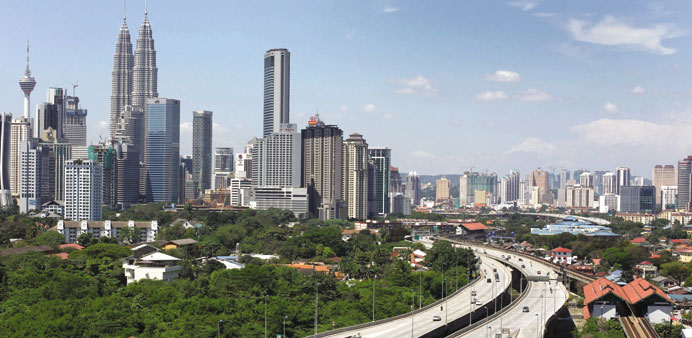An elevated view of the skyline in Kuala Lumpur. The value of total investable real estate in developing Asia-Pacific countries, including the ”tiger cub countries” in Southeast Asia such as Thailand, Vietnam, Malaysia and the Philippines, will surge by 140% to $10.2tn by 2020, from $4.3tn in 2012, a PwC report said.
The value of global fund assets is expected to surge by 60% to $101.7tn by 2020, fuelled by substantial growth of “investable” real estate especially in developing economies, a recently released report by PwC entitled “Real Estate 2020: Building the Future stated.”
Sovereign wealth funds and high-net worth individuals, a significant portion of them from the Middle East, as well as other state funds, will boost the asset growth on the investors’ side, while recipients of the funds will be mainly real estate markets in developing countries of Asia-Pacific, the report said.
It stated that Emerging Asia is expected to be the fastest growing region for construction between now and 2025, followed by sub-Saharan Africa, and this will lure a number of sovereign wealth funds from the Middle East to these markets, all of which will mainly compete for prime real estate. The value of total investable real estate in developing Asia-Pacific countries, including the “tiger cub countries” in Southeast Asia such as Thailand, Vietnam, Malaysia and the Philippines, will surge by 140% to $10.2tn by 2020, from $4.3tn in 2012, the report said. This growth will outpace developed Asia-Pacific nations (which include Australia, Hong Kong, Japan, Korea, New Zealand, Singapore and Taiwan), as well as the US, Canada and Europe.
At the same time, sovereign wealth funds are set to grow by more than 70% to $8.9tn by 2020, mainly driven by the Middle East, where some of the largest such funds worldwide can be found, such as the Abu Dhabi Investment Authority, Saudi Arabia’s SAMA (the Saudi Arabian Monetary Agency, the Kingdom’s central bank), the Kuwait Investment Authority and the Qatar Investment Authority. These will have to compete mainly with large sovereign wealth funds from China, Hong Kong and Singapore. On the other hand, high-net-worth individuals will increase their assets by almost 50% to $76.9tn in the same period, funds that are ready to invest in real estate and are increasingly switching their asset allocation into that direction.
“The global investable real estate universe will expand substantially, leading to a huge expansion in opportunity, especially in emerging economies,” says Kees Hage, Global Real Estate Leader at PwC. “By 2025, there will be 37 ‘megacities’, up from 23 today, and 12 of these will be in emerging markets,” he added.
Meanwhile, UK-based real estate consultancy firm Savills has issued a global ranking of cities which have the best global competitiveness, prominence, long-term appeal and stability in the property sector – and ranked no less than seven cities in East and South Asia, the Middle East and Australia among the top 10. The cities are Singapore, Hong Kong, Tokyo, Shanghai, Dubai, Sydney and Mumbai, and their “investability” will “shape the future of the world’s property market,” the study said. It also recommended investors to look at what it defines as being second-tier cities such as Hanoi, Kuala Lumpur, Jakarta and Bangkok to watch in the coming years as they “could offer good alternatives” to property investors as opposed to “fully valued” markets such as Dubai or Hong Kong.

